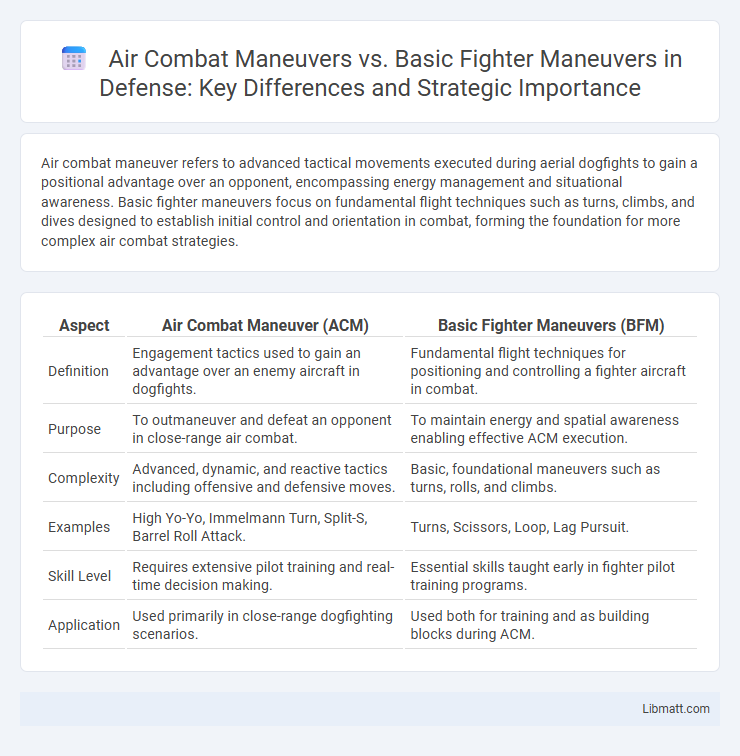Air combat maneuver refers to advanced tactical movements executed during aerial dogfights to gain a positional advantage over an opponent, encompassing energy management and situational awareness. Basic fighter maneuvers focus on fundamental flight techniques such as turns, climbs, and dives designed to establish initial control and orientation in combat, forming the foundation for more complex air combat strategies.
Table of Comparison
| Aspect | Air Combat Maneuver (ACM) | Basic Fighter Maneuvers (BFM) |
|---|---|---|
| Definition | Engagement tactics used to gain an advantage over an enemy aircraft in dogfights. | Fundamental flight techniques for positioning and controlling a fighter aircraft in combat. |
| Purpose | To outmaneuver and defeat an opponent in close-range air combat. | To maintain energy and spatial awareness enabling effective ACM execution. |
| Complexity | Advanced, dynamic, and reactive tactics including offensive and defensive moves. | Basic, foundational maneuvers such as turns, rolls, and climbs. |
| Examples | High Yo-Yo, Immelmann Turn, Split-S, Barrel Roll Attack. | Turns, Scissors, Loop, Lag Pursuit. |
| Skill Level | Requires extensive pilot training and real-time decision making. | Essential skills taught early in fighter pilot training programs. |
| Application | Used primarily in close-range dogfighting scenarios. | Used both for training and as building blocks during ACM. |
Introduction to Air Combat Maneuvers
Air combat maneuvers encompass advanced tactical techniques used by fighter pilots to gain positional advantage and ensure kill opportunities during aerial engagements. Basic fighter maneuvers (BFM) form the foundational skills of air combat, emphasizing energy management, turn radius, and speed control to outmaneuver opponents. Mastery of BFM is essential before progressing to complex air combat maneuvers, which integrate situational awareness and multi-dimensional strategies for superior engagement outcomes.
Defining Basic Fighter Maneuvers (BFM)
Basic Fighter Maneuvers (BFM) are tactical movements executed by fighter pilots to gain a positional advantage over an adversary during aerial combat. These maneuvers focus on controlling energy, speed, and angle of attack to outmaneuver opponents and achieve a favorable firing position. Techniques such as the high yo-yo, barrel roll, and scissors are core BFM strategies used to effectively manage situational awareness and aircraft performance.
Historical Evolution of Air Combat Tactics
Air combat maneuver (ACM) techniques have evolved significantly since World War I, where pilots relied on basic fighter maneuvers (BFM) for dogfighting. Early ACM developed from BFM to incorporate advanced strategies influenced by aircraft technology improvements and radar systems, shifting from close-range engagements to beyond visual range tactics. Your understanding of air combat is enhanced by studying how this historical evolution reflects changes in aerial combat doctrines and pilot training.
Key Differences: Air Combat Maneuver vs Basic Fighter Maneuvers
Air Combat Maneuvering (ACM) involves complex, real-time tactical engagements emphasizing situational awareness, energy management, and precision targeting to gain positional advantage over enemy aircraft. Basic Fighter Maneuvers (BFM) serve as foundational aerial combat techniques focused on fundamental principles such as turn rate, angle of attack, and speed control to prepare pilots for more advanced ACM scenarios. The key difference lies in ACM's application during active dogfights requiring adaptive strategy, whereas BFM primarily trains pilots in essential control and positioning skills.
Role and Importance of Situational Awareness
Air combat maneuver (ACM) emphasizes advanced tactical positioning and rapid decision-making to gain an advantage in close-range dogfighting, relying heavily on heightened situational awareness to anticipate enemy moves and maintain dominance. Basic fighter maneuvers (BFM) establish the foundational skills for aircraft control and engagement strategies, where situational awareness is critical for recognizing threats and executing timely defensive or offensive actions. Both ACM and BFM depend on continuous monitoring of the pilot's environment, radar, and visual cues to optimize aircraft positioning and ensure survival in dynamic air combat scenarios.
Notable Air Combat Maneuver Examples
Notable air combat maneuver examples include the Immelmann turn, a defensive and offensive tactic enabling rapid altitude gain and position reversal, and the Split-S, which quickly shifts an aircraft's direction by a half-roll followed by a dive. Basic fighter maneuvers, such as the barrel roll and scissors, focus on maintaining positional advantage and energy management during close-range engagements. Your mastery of these maneuvers can significantly impact your effectiveness in dogfights and tactical aerial engagements.
Basic Fighter Maneuvers: Core Techniques Explained
Basic Fighter Maneuvers (BFM) encompass essential aerial combat techniques such as turns, rolls, and stalls designed to gain positional advantage over an opponent. Mastery of core BFM enables pilots to efficiently manage energy, speed, and angle of attack to outmaneuver adversaries during close-range engagements. These fundamental tactics form the foundation of advanced air combat maneuvering, directly impacting dogfight success rates and pilot survivability.
Training and Simulation in Modern Air Combat
Training in air combat maneuver and basic fighter maneuvers relies heavily on advanced simulation technologies, including virtual reality and AI-driven scenarios, to replicate realistic combat environments. These simulations enhance pilot skills by providing real-time feedback, adaptive threat responses, and customizable mission parameters, leading to improved decision-making and situational awareness. Integration of high-fidelity simulators with live training exercises ensures comprehensive preparation for modern aerial engagements and complex tactical environments.
Technological Advancements Impacting Maneuvers
Technological advancements such as thrust-vectoring engines, helmet-mounted displays, and advanced radar systems have transformed air combat maneuvers from traditional Basic Fighter Maneuvers (BFM) into more sophisticated, high-precision engagements. These innovations enable pilots to execute complex maneuvers with increased situational awareness and agility, reducing reaction times and enhancing target tracking capabilities. Modern Air Combat Maneuvers (ACM) incorporate these technologies to maximize energy management and exploit sensor fusion, significantly improving combat effectiveness beyond classical BFM techniques.
Future Trends in Air Combat Strategy
Air combat maneuver (ACM) tactics are rapidly evolving as advanced technologies such as artificial intelligence, sensor fusion, and network-centric warfare redefine the future battlefield beyond traditional basic fighter maneuvers (BFM). These future trends emphasize beyond-visual-range engagements, cooperative unmanned systems, and enhanced situational awareness to maintain air superiority. Your ability to adapt to these innovations will be crucial in mastering next-generation air combat strategies.
Air combat maneuver vs Basic fighter maneuvers Infographic

 libmatt.com
libmatt.com